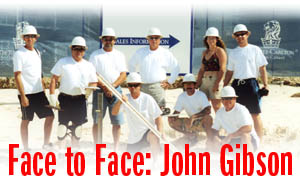

John Gibson: I started Gibson Plastering, August 1982. The first two years I had a small crew of eight mechanics and did residential and light commercial jobs. The company grew from there. We did interior and exterior lath and plaster on residential homes, small commercial projects (banks, restaurants)-anything related to lath and plaster. As years went by, we focused more on commercial projects such as office buildings and hotels. The company is still relatively small averaging about 30 employees.
W&C: Now that you've achieved a certain level of success, what do you want to do for the lath and plaster industry?
J.G.: Communicate with architects and owners to educate them on the fundamentals of plastering. Get the truth out to these people. I want to eliminate all the other negative information about stucco that people have been preaching for years. After all, it's not what a person says or does, it's what he can prove. After 23 years, I can look back at 6 million square feet of cement plaster installed, according to ASTM C-926 and ASTM 1063, and it's all still there. No one knows how long it will last until it breaks down into dust. Cement manufactured today is better than what the Egyptians, Greeks and Romans had, and their cement plaster lasted for hundreds of years.
W&C: You've become very successful. How?
J.G.: As in any business, perform first-class quality work, complete the work ahead of schedule and do it for the right price. Implement these three things and you will be a success in your field. Be a sponge and soak up all the knowledge you can about your trade. I was fortunate to have served my apprenticeship under union mechanics who were at the top of this trade historically in this country. Once you are skilled at your trade then it's just a matter of how hard you want to work. A nozzle man does nothing short of hard physical work, so I really didn't have a lot of competition. Everyone else was out there sticking foam.
W&C: What other traits do you feel are essential ingredients to success?
J.G.: Always be honest and never cheat. When you make a mistake, pay for it yourself. For example, if you missed some footage on your takeoff and your profit is not what you hoped, still complete the job the right way whether you make money or not. Always do the right thing and don't be a crybaby. Your work is who you are.
W&C: What have you seen happen in the industry in your time, negative and positive?
J.G.: The biggest negative thing, as far as the plastering trade, is when unions went out because this meant the apprenticeship program went out and there was no longer an AFL/CIO-accredited three-year program in the trade. What happened was when drywall came out, the lathers' union didn't want to do it. That new industry was looking for an existing union to take drywall into their trade. It wasn't carpentry so they turned from that union and looked to lathers but they didn't want it because they didn't think it would last. They thought it was a cheap product. If the lathers had accepted drywall, drywall hangers would be called "lathers" today.
The drywallers formed a second local in the carpenters' union called drywall hangers and the lathers went away. The only work they had was putting up metal lath, suspended ceilings and that was not enough to sustain them. They tried to merge into the carpenters local but that didn't happen. The biggest loss is not so much hawk-and-trowel men but lathers-they're the ones who've gone. The problem caused by these circumstances has to do with the ability to apply plaster in its right thickness. People put it on too thin because there are no lathers to do all the mechanic work to get the surface ready for the proper plaster thickness.
W&C: What about some
positive changes?
J.G.: Cement plaster is coming back because people have learned their lesson. Basically, I've made a lot of money because of EIFS by not doing EIFS. When the EIFS market first came about, many manufacturers were pushing the product, beating on architects' doors and marketing well. There's no one promoting plaster and stucco. The union used to promote it and go to trade shows but once the union crashed, there was nobody promoting lath and plaster; just EIFS. They went out there trying to make people think this is the new and better way, etc., talking about how it costs less than real cement plaster and bad mouthing cement plaster, which has been around for thousands of years. There was nobody to follow behind them and contradict this, that you can do stucco for less than EIFS but they scared people away from it.
I could only go out and put up cement plaster and see how it performed over time. Twenty-five years later, I have 6 million square feet of cement plaster and not one problem. Why not? No claims, no water intrusion, everyone happy, everyone wants more of it. Some of the projects we have worked on are Disney, Marriott Vacation Club, the Ritz-Carlton. We don't have any problems and never did. Now, there are so many mindsets on how to do cement plaster stucco. There's only one way to do it right. The standards were set years ago. The old ASTM C-926: Follow this and there are no problems with cement plaster. They say, put this in the mix, put it on this thick. All you need is someone who knows the craft, someone who's a real plasterer, along with some Portland cement sand and steel, and the building will last for hundreds of years. One can build anything with this material. We've gone (away) from simple craftsmanship and raw materials. No plastics, acrylics, all the foamy stuff-there's no replacing 1-inch-thick Portland cement with an inch of Styrofoam.
W&C: Do you see this changing?
J.G.: It's already happening: People are getting back to common sense. With EIFS, the price has gone out the roof to prevent things from happening that don't happen if it's done right. I think EIFS does have its place, in strip malls and shopping centers, where there is no living space behind the wall. But if you want to build a structure to protect the inside from the elements, I'd go precast stone or Portland cement stucco.
This argument went on for years. Friends of mine that I grew up with went the EIFS route and became EIFS applicators in the Atlanta area. I stayed with lath and plaster, did jobs in office buildings, suspended plaster ceilings, stucco on the outside, etc. Friends were out doing whole building in EIFS, which steered me to the coast of South Carolina where we got to do the entire building out of stucco. EIFS was everywhere. The only way anyone could win this argument was to wait and see whose walls are still standing. All of mine are up.
W&C: How do you plan to spread the word about stucco?
J.G.: I've been talking to other contractors. They know why we're successful and why it's turning around: because we're doing it how it used to be done decades ago. They're seeing it now. Our door is open to anyone who wants to see what we're doing. It's customary for a brother plasterer to pass on any information he can to another brother plasterer. I know a lot of plasterers out there who would say, "I know about pumping and all that," but they're too old to do it. It's a young man's job to be at the end of a nozzle. I've found people but it's been hard. Once they get a taste of the dough, there's no looking back. When I made 10 grand in one day, there was no looking back for me! "This is hard work," I thought, "but I'm gonna suck it up and do it!"
W&C: What about the characteristics of a company and its workers?
J.G.: One must create a company that's like a family. Employees who are dedicated, motivated, take pride in their work and the trade seriously. These workers are extremely important to the overall success of the company. The company seeks out the right people who want to work hard, be soaking wet in sweat, working on a gun crew and performing this kind of work. Once you find the people, train them in both lath and plastering. Inform them there's a secure future in the trade and they can make as much money as they want. Use me as an example. I started at 19 years old and retired from the scaffold at 45. I want to demonstrate and mentor the apprentices exactly the opportunities that can be achieved. Search out old lathers who can teach the trade. The only lathers I've come across recently are older lathers my age. Teaching someone to apply EIFS takes about a week. Learning to become a mechanic lather or plasterer takes years. People in the past have seen and believed in the highest of standards and quality of work performed in the trade. We want everyone at the present and in the future to see and believe in this trade. I anticipate this trade to continue into the future to be even more successful for all those who want to keep the old traditions and customs of the craft alive.

Report Abusive Comment